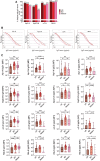Diversity in Naturally Acquired Immunity to Group B Streptococcus: A Comparative Study of Women From Bangladesh, Malawi, and the United Kingdom
- PMID: 39692506
- PMCID: PMC11841642
- DOI: 10.1093/infdis/jiae607
Diversity in Naturally Acquired Immunity to Group B Streptococcus: A Comparative Study of Women From Bangladesh, Malawi, and the United Kingdom
Abstract
Background: Significant disparities in group B Streptococcus (GBS) colonization and neonatal disease rates have been documented across different geographic regions. For example, Bangladesh reports notably lower rates as compared with the United Kingdom and Malawi. This study investigates whether this epidemiologic variability correlates with the immune response to GBS in these regions.
Methods: Qualitative and quantitative analyses of naturally acquired immunoglobulin G (IgG) antibodies against GBS capsular polysaccharide and the Alp protein family were conducted in serum samples from women of childbearing age in the United Kingdom, Bangladesh, and Malawi. The efficacy of these antibodies in clearing vaginal colonization or protecting newborns from GBS infection was assessed with humanized mouse models.
Results: Bangladeshi women displayed the highest diversity in serotype distribution, with elevated IgG levels in the serum against GBS capsular polysaccharides Ia, Ib, II, III, IV, and V, as well as Alp family proteins. In contrast, Malawian sera demonstrated the weakest antibody response. Bangladeshi sera also showed heightened IgG-mediated complement deposition, opsonophagocytic killing, and neonatal Fc receptor binding while tested against capsular polysaccharide Ib. In a humanized neonatal Fc receptor mouse model, Bangladeshi sera led to faster clearance of GBS virulent serotype Ib vaginal colonization. Additionally, offspring from dams passively immunized with Bangladeshi sera demonstrated notably increased survival rates.
Conclusions: This study demonstrates significant variability in the immune response to GBS across different geographic regions. These findings underscore the importance of understanding GBS-induced immune response in diverse populations, which may significantly affect vaccine efficacy in these regions.
Keywords: Alp protein; antibody diversity; capsular polysaccharide; group B Streptococcus; mouse model.
© The Author(s) 2024. Published by Oxford University Press on behalf of Infectious Diseases Society of America.
Conflict of interest statement
Potential conflicts of interests. J. L. is an employee at MinervaX, receives salary, and has been allocated warrants in MinervaX in accordance with the company's articles of association. The employment presents both a financial and nonfinancial interest, and the warrant allocation presents a potential financial interest. All other authors report no potential conflicts.
Figures





Similar articles
-
The Protective Value of Maternal Group B Streptococcus Antibodies: Quantitative and Functional Analysis of Naturally Acquired Responses to Capsular Polysaccharides and Pilus Proteins in European Maternal Sera.Clin Infect Dis. 2016 Sep 15;63(6):746-753. doi: 10.1093/cid/ciw377. Epub 2016 Jul 11. Clin Infect Dis. 2016. PMID: 27402816
-
Natural acquired humoral immunity against serotype-specific group B Streptococcus rectovaginal colonization acquisition in pregnant women.Clin Microbiol Infect. 2015 Jun;21(6):568.e13-21. doi: 10.1016/j.cmi.2015.01.030. Epub 2015 Feb 10. Clin Microbiol Infect. 2015. PMID: 25680313
-
Association between anti-capsular IgG levels at birth and risk of invasive group B streptococcus disease in Finnish newborns: a retrospective case-control study.Lancet Microbe. 2024 Jul;5(7):689-696. doi: 10.1016/S2666-5247(24)00038-7. Epub 2024 Apr 26. Lancet Microbe. 2024. PMID: 38679040
-
Group B Streptococcus: developing a correlate of protection for a vaccine against neonatal infections.Curr Opin Infect Dis. 2016 Jun;29(3):262-7. doi: 10.1097/QCO.0000000000000266. Curr Opin Infect Dis. 2016. PMID: 26926474 Review.
-
Group B streptococcal vaccines.Rev Infect Dis. 1985 Jul-Aug;7(4):458-67. doi: 10.1093/clinids/7.4.458. Rev Infect Dis. 1985. PMID: 3898306 Review.
References
-
- Edmond KM, Kortsalioudaki C, Scott S, et al. Group B streptococcal disease in infants aged younger than 3 months: systematic review and meta-analysis. Lancet 2012; 379:547–56. - PubMed
-
- Kwatra G, Cunnington MC, Merrall E, et al. Prevalence of maternal colonisation with group B Streptococcus: a systematic review and meta-analysis. Lancet Infect Dis 2016; 16:1076–84. - PubMed
Publication types
MeSH terms
Substances
Grants and funding
LinkOut - more resources
Full Text Sources
Medical

